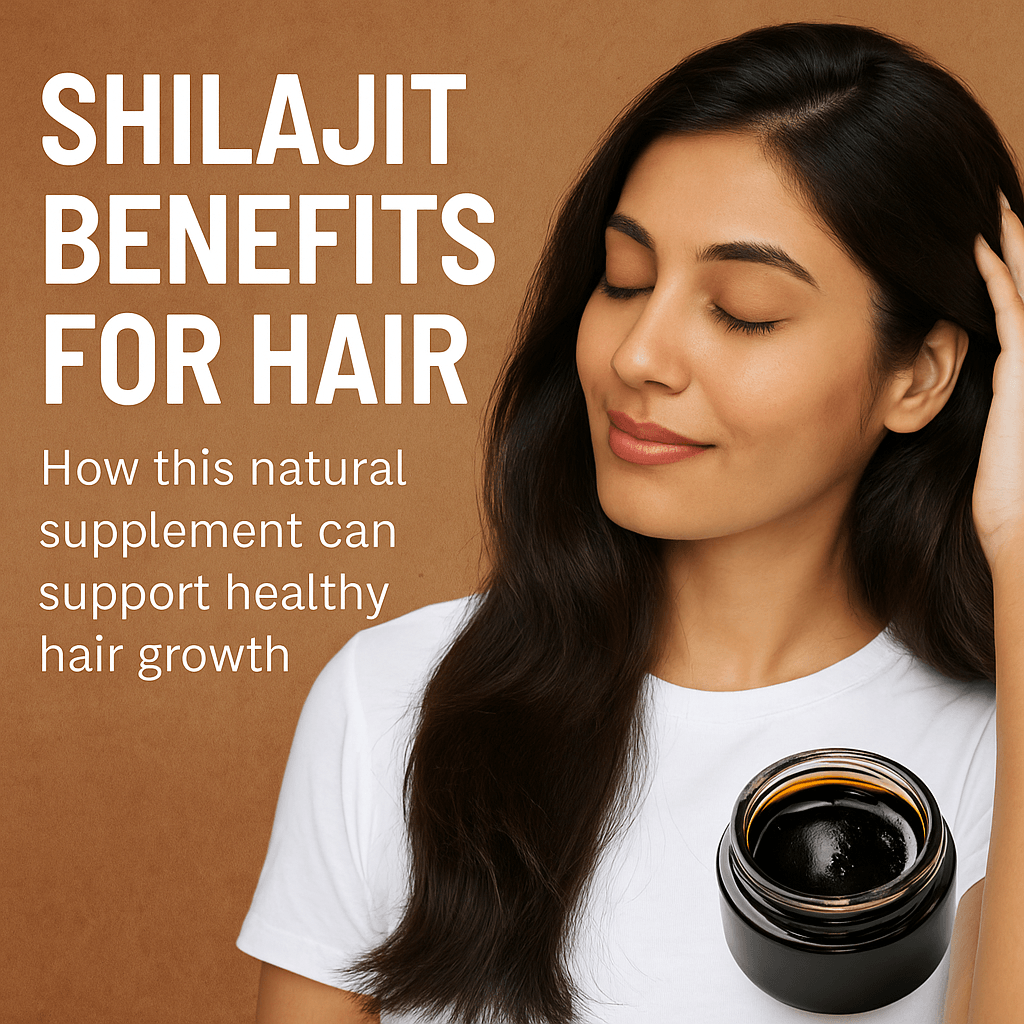Shilajit benefits for hair are gaining attention as more people seek natural remedies for hair loss, thinning hair, and poor hair. Whether it’s due to stress, poor nutrition, hormonal imbalances, or environmental damage, people are increasingly looking for natural solutions to support healthy hair growth.
Among Ayurvedic remedies, Shilajit is emerging as a powerful supplement — not just for general health and vitality, but also for its potential role in improving hair health. Rich in minerals, fulvic acid, and antioxidants, Shilajit is now being explored as a supportive remedy for hair fall, weak roots, and lacklustre hair.
But does it really work? And if yes, how should one use Shilajit for maximum benefit?
In this article, we’ll take a closer look at:
- How Shilajit supports hair growth and scalp health
- What scientific and traditional evidence suggests
- The best ways to use Shilajit for hair
- Key precautions and tips for real results
Let’s explore whether Shilajit for hair is just a trend — or a time-tested solution worth adding to your wellness routine.
Why Shilajit Benefits for Hair Are Scientifically Backed?
Shilajit has long been valued in Ayurveda for its rejuvenating properties — but its benefits for hair health are now gaining recognition among modern wellness enthusiasts. When it comes to hair growth, scalp strength, and follicle nourishment, Shilajit offers a unique blend of compounds that can support and complement a holistic hair care routine.
1. Rich in Fulvic Acid, Minerals, and Antioxidants
The primary components of Shilajit — fulvic acid, trace minerals, and antioxidants — all play a critical role in maintaining healthy hair. Fulvic acid, in particular, is known for enhancing nutrient absorption and cellular function, which can directly benefit the scalp and hair follicles.
2. Improved Blood Circulation to the Scalp
One of the key ways Shilajit supports hair growth is by improving microcirculation in the scalp. Better blood flow means more oxygen and nutrients are delivered to the hair roots — resulting in stronger, healthier hair follicles. Poor circulation is a hidden factor behind hair thinning, especially in urban lifestyles.
3. Trace Minerals for Keratin Production
Hair is primarily made up of keratin, a protein that requires adequate mineral support for synthesis. Shilajit contains small but essential amounts of zinc, iron, magnesium, and copper — all of which contribute to the structural strength and growth cycle of hair. A deficiency in these minerals can lead to brittle hair and slowed regrowth.
4. Antioxidant Action Against Hair Follicle Damage
Oxidative stress — caused by pollution, poor diet, and stress — is a major contributor to hair fall and early greying. The antioxidant profile of Shilajit may help neutralize free radicals, protecting the scalp environment and slowing down damage to the hair roots.
5. Fulvic Acid for Texture and Shine
Many users report that regular use of Shilajit improves hair texture, strength, and shine. Fulvic acid helps detoxify cells and enhance absorption of nutrients, which may indirectly lead to smoother, more resilient hair strands over time.
While Shilajit shows great promise as a hair health supplement, it is not a miracle cure. Think of it as a supportive tool that works best when combined with a nutritious diet, proper scalp care, and stress management. Results are gradual and require consistent use over a period of weeks.
Scientific Perspective → What Does Research Say?
When it comes to Shilajit for hair growth, there are currently no large-scale clinical studies directly linking it to faster regrowth or hair density improvement. However, modern research on its individual properties offers strong indirect support for its role in improving hair health.
Antioxidant Action → Protects Hair Follicles
One of the most well-documented properties of Shilajit is its antioxidant capacity, largely due to its high fulvic acid content. Several studies confirm that antioxidants help reduce oxidative stress — a major factor behind hair follicle damage, hair thinning, and premature greying.
Oxidative stress weakens the scalp environment and accelerates follicular aging. By neutralizing free radicals, Shilajit may help maintain healthy follicles and prolong the active growth phase of hair (anagen phase).
Mineral Support for Hair Growth
Shilajit is a natural source of trace minerals like iron, zinc, copper, and magnesium — all of which play a key role in the hair growth cycle.
- Zinc helps regulate sebum production and supports follicle recovery.
- Iron is essential for oxygen transport to the scalp.
- Copper supports melanin production (important for hair pigment).
- Magnesium improves protein synthesis and scalp health.
Deficiencies in these minerals are commonly associated with hair loss, especially in women.
Stress Reduction Through Adaptogenic Effect
Chronic stress is a silent enemy of healthy hair — leading to cortisol spikes that can disrupt the hair cycle and trigger shedding (telogen effluvium).
Shilajit has adaptogenic properties, meaning it helps the body adapt to stress more efficiently. Some studies have observed that regular supplementation can lower cortisol levels, thereby creating a more favorable hormonal environment for hair maintenance.
While more direct clinical trials on Shilajit and hair growth are needed, its combined effects on oxidative stress, nutrient replenishment, and hormonal balance make it a promising natural option for supporting long-term hair health.
How to Use Shilajit for Hair Growth & Benefits?
To experience the hair-related benefits of Shilajit, how you use it makes a significant difference. While it’s commonly marketed in various forms, the most effective method is internal use — allowing the bioactive compounds to work systemically.
Internal Use → Most Effective
If your goal is to support hair growth and scalp health, taking Shilajit orally — in the form of resin or capsules — is the best option. This method allows its minerals, fulvic acid, and antioxidant compounds to nourish the body from within.
Recommended Dosage:
- Start with 300–500 mg per day, ideally in the morning on an empty stomach.
- You can take it once or split it into two doses (morning + early evening).
Consistency is key — most users report visible results after 6–8 weeks of daily use.
Read: How to Take Shilajit: Complete Dosage & Usage Guide
Topical Application → Limited Evidence
Some Ayurvedic and herbal hair care brands have started marketing Shilajit-infused oils or scalp masks. While there’s no strong clinical evidence for topical Shilajit improving hair growth directly, it may still offer complementary benefits.
How to apply Shilajit to hair topically:
- Mix a small pea-sized amount of Shilajit resin into 1–2 tablespoons of a carrier oil (such as coconut oil, argan oil, or bhringraj oil).
- Warm the oil slightly and massage gently into the scalp.
- Leave on for 30–60 minutes.
- Rinse thoroughly with a mild, herbal shampoo.
Caution: Always do a patch test first. Shilajit is potent and may cause irritation in some individuals with sensitive skin.
Combination Approach for Best Results
To maximize the benefits, consider a dual approach:
- Primary: Oral supplementation (resin or capsule).
- Optional: Topical oil massage once or twice a week.
This combo supports the body’s internal nutrient and hormonal balance while nourishing the scalp directly.
Remember, Shilajit is not a standalone solution. For optimal hair results, combine it with:
- A balanced diet rich in protein and minerals
- Proper scalp hygiene
- Stress management practices (yoga, sleep, mindfulness)
When used thoughtfully, Shilajit can become a valuable part of your long-term hair wellness routine.
Precautions & Things to Keep in Mind
While Shilajit offers promising support for hair health, it’s important to use it correctly and cautiously — especially if you’re new to herbal supplements.
1. Always Choose Pure, Lab-Tested Shilajit
The biggest risk with Shilajit lies in contamination. Many low-cost or fake products on the market may contain:
- Heavy metals
- Added fillers
- Synthetic resins
These can do more harm than good, especially when applied topically or consumed long-term.
Look for:
- Third-party lab testing
- Clearly mentioned fulvic acid content
- Himalayan or Altai origin resin
2. Start with a Small Dose & Monitor
If you’re taking Shilajit orally, begin with the lowest recommended dosage (typically ~300 mg/day). Gradually increase only if your body tolerates it well.
Possible mild side effects in rare cases:
- Upset stomach
- Headache
- Increased body heat
If you have underlying health conditions or are taking medications, consult your doctor before starting.
3. Do a Patch Test for Topical Use
Shilajit resin is powerful. When using it in a DIY scalp oil or mask:
- Always do a patch test on your arm before applying to the scalp.
- Watch for signs of irritation, redness, or itching.
If no reaction occurs in 24 hours, it’s generally safe to proceed.
4. Consistency is Key (But Be Patient)
Shilajit is not an overnight miracle. Hair growth is a slow biological process. Most users begin to notice results in:
- 6–8 weeks of daily use
- Greater improvement after 3 months
Don’t give up too early — consistency is crucial.
5. Shilajit is Supportive, Not a Standalone Fix
For best results, use Shilajit as part of a holistic hair wellness routine, including:
- A nutrient-rich diet (rich in iron, zinc, protein)
- Stress management (chronic stress causes hair loss)
- Proper scalp care and hygiene
Used wisely, Shilajit can become a powerful ally in your journey toward healthier, stronger hair.
Conclusion
Hair health is influenced by many factors — nutrition, stress, genetics, and overall wellness. Shilajit can play a powerful supporting role in your hair care routine thanks to its rich mineral profile, antioxidant properties, and adaptogenic effects.
By improving blood circulation, reducing oxidative stress, and supplying essential trace minerals like zinc and iron, Shilajit helps create a healthier scalp environment — which is crucial for stronger, thicker hair growth.
However, it’s important to remember: Shilajit is not a magical cure for baldness. It works best when used consistently as part of a broader strategy that includes good nutrition, scalp care, and stress reduction.
For best results: Use pure, high-quality Shilajit resin or capsules, and give it at least 6–8 weeks of regular use.
References
- Shilajit: A Natural Phytocomplex with Potential Benefits
- A review of Shilajit’s components and bioactive benefits including fulvic acid, antioxidant, and adaptogenic properties.
- Link: https://www.ncbi.nlm.nih.gov/pmc/articles/PMC3296184/
- Zinc and Hair Loss: Current Opinion
- Discusses the role of zinc in the hair growth cycle and how deficiency contributes to hair fall.
- Link: https://www.ncbi.nlm.nih.gov/pmc/articles/PMC5315033/
- Role of Minerals in Hair Growth
- Covers how trace minerals like iron, copper, and magnesium support hair health.
- Link: https://www.ncbi.nlm.nih.gov/pmc/articles/PMC4387693/
- Oxidative Stress and Hair Loss
- Explains how free radical damage affects scalp and follicle health, leading to hair thinning.
- Link: https://www.ncbi.nlm.nih.gov/pmc/articles/PMC2929555/
- Adaptogens and Stress Reduction
- General study on how adaptogenic herbs like Shilajit may help lower cortisol and manage stress-induced hair loss.
- Link: https://www.ncbi.nlm.nih.gov/pmc/articles/PMC6240259/
- Traditional Use of Shilajit in Ayurveda
- Overview of Shilajit’s use in classical Ayurvedic texts for rejuvenation (Rasayana) and hair vitality.
- Link: https://www.ncbi.nlm.nih.gov/books/NBK92751/


